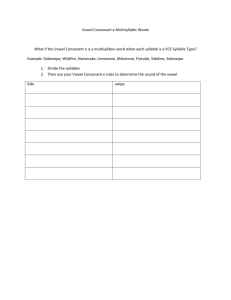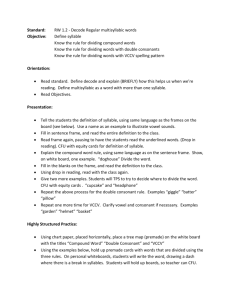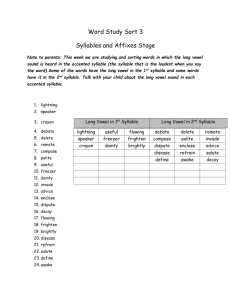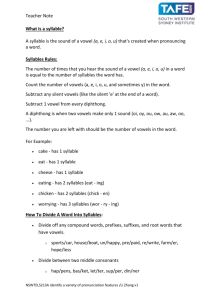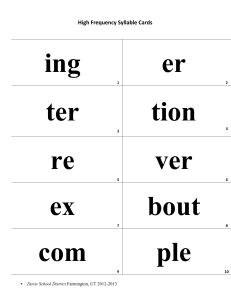Syllables and Syllable Structure: A Linguistics Overview
advertisement
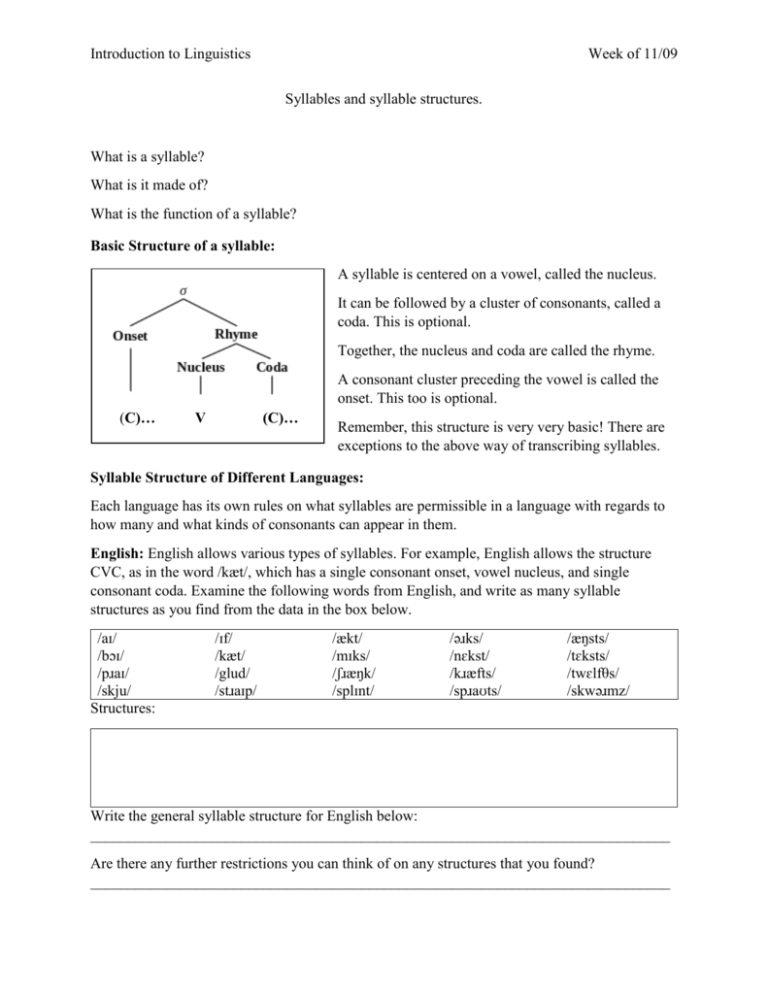
Introduction to Linguistics Week of 11/09 Syllables and syllable structures. What is a syllable? What is it made of? What is the function of a syllable? Basic Structure of a syllable: A syllable is centered on a vowel, called the nucleus. It can be followed by a cluster of consonants, called a coda. This is optional. Together, the nucleus and coda are called the rhyme. A consonant cluster preceding the vowel is called the onset. This too is optional. (C)… (C)… V Remember, this structure is very very basic! There are exceptions to the above way of transcribing syllables. Syllable Structure of Different Languages: Each language has its own rules on what syllables are permissible in a language with regards to how many and what kinds of consonants can appear in them. English: English allows various types of syllables. For example, English allows the structure CVC, as in the word /kӕt/, which has a single consonant onset, vowel nucleus, and single consonant coda. Examine the following words from English, and write as many syllable structures as you find from the data in the box below. /aɪ/ /bɔɪ/ /pɹaɪ/ /skju/ Structures: /ɪf/ /kӕt/ /glud/ /stɹaɪp/ /ӕkt/ /mɪks/ /ʃɹӕŋk/ /splɪnt/ /əɹks/ /nɛkst/ /kɹӕfts/ /spɹaʊts/ /ӕŋsts/ /tɛksts/ /twɛlfθs/ /skwəɹmz/ Write the general syllable structure for English below: _____________________________________________________________________________ Are there any further restrictions you can think of on any structures that you found? _____________________________________________________________________________ ɪӕɯɾɹʃɛɔŋʒəθʊɨ Introduction to Linguistics Week of 11/09 Japanese: Now look at words from Japanese and make the same judgements. /e/ “painting” /ki/ “tree” /naN/ “what” /tja/ “tea” /o/ honorific pref. /jɯ/ “hot water” /meN/ “noodles” /sjɯ/ “variety” /aa/ “that way” /te/ “hand” /ɾiN/ “wheel” /zjo/ female compounding /ii/ “good” /no/ “ ‘s ” /hoN/ “book” suf. /ɯN/ “yeah” /wa/ “harmony” /bɯN/ “part” /eN/ “yen” /sɯ/ “vinegar” Note: /N/ is a generic nasal sound, /ɯ/ is a high, back, unrounded vowel Structures: /njaN/ “meow” /kjɯN/ “throb” /tjoN/ “dash/mark” Write the general syllable structure for Japanese below: _____________________________________________________________________________ Are there any further restrictions you can think of on any structures that you found? _____________________________________________________________________________ Russian: Now look at words from Russian and make the same judgements. /i/ /da/ /dva/ /vsje/ “and” “yes” “two” “all” /ot/ “from” /kot/ “cat” /njet/ “no” /vdrug/ “sudden” /vzljot/ “takeoff” /vzgljad/ “glance” /isk/ “claim” /rost/ “growth” /pjatj/ “five” /zdjesj/ “here” /vskrɨtj/“to open” /doʒdj/ “rain” /vslastj/ “to your heart’s content” /tsarstv/ “of kingdoms” /dvovstv/ “of widowhoods” Structures: Write the general syllable structure for Russian below: _____________________________________________________________________________ Are there any further restrictions you can think of on any structures that you found? _____________________________________________________________________________ ɪӕɯɾɹʃɛɔŋʒəθʊɨ






